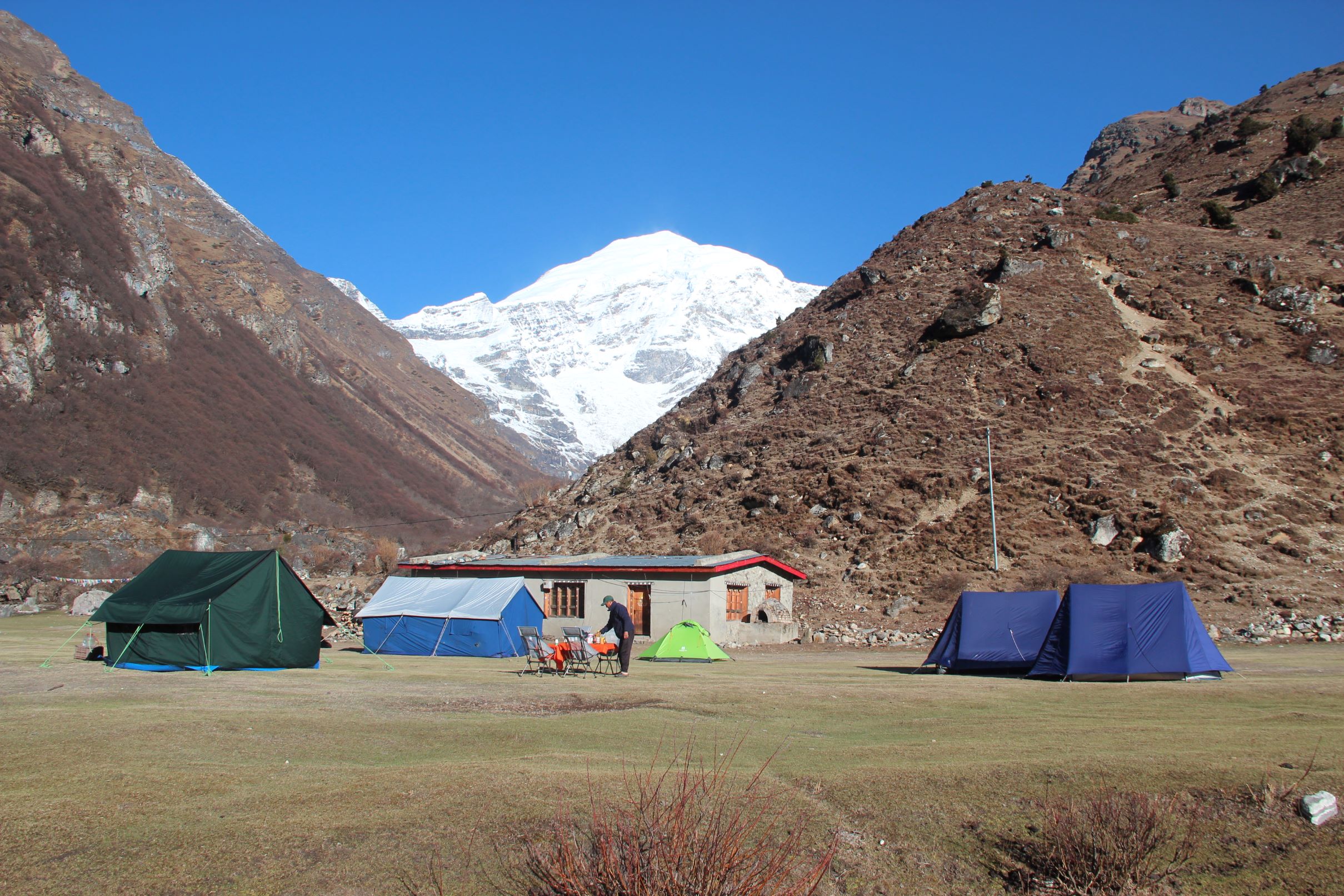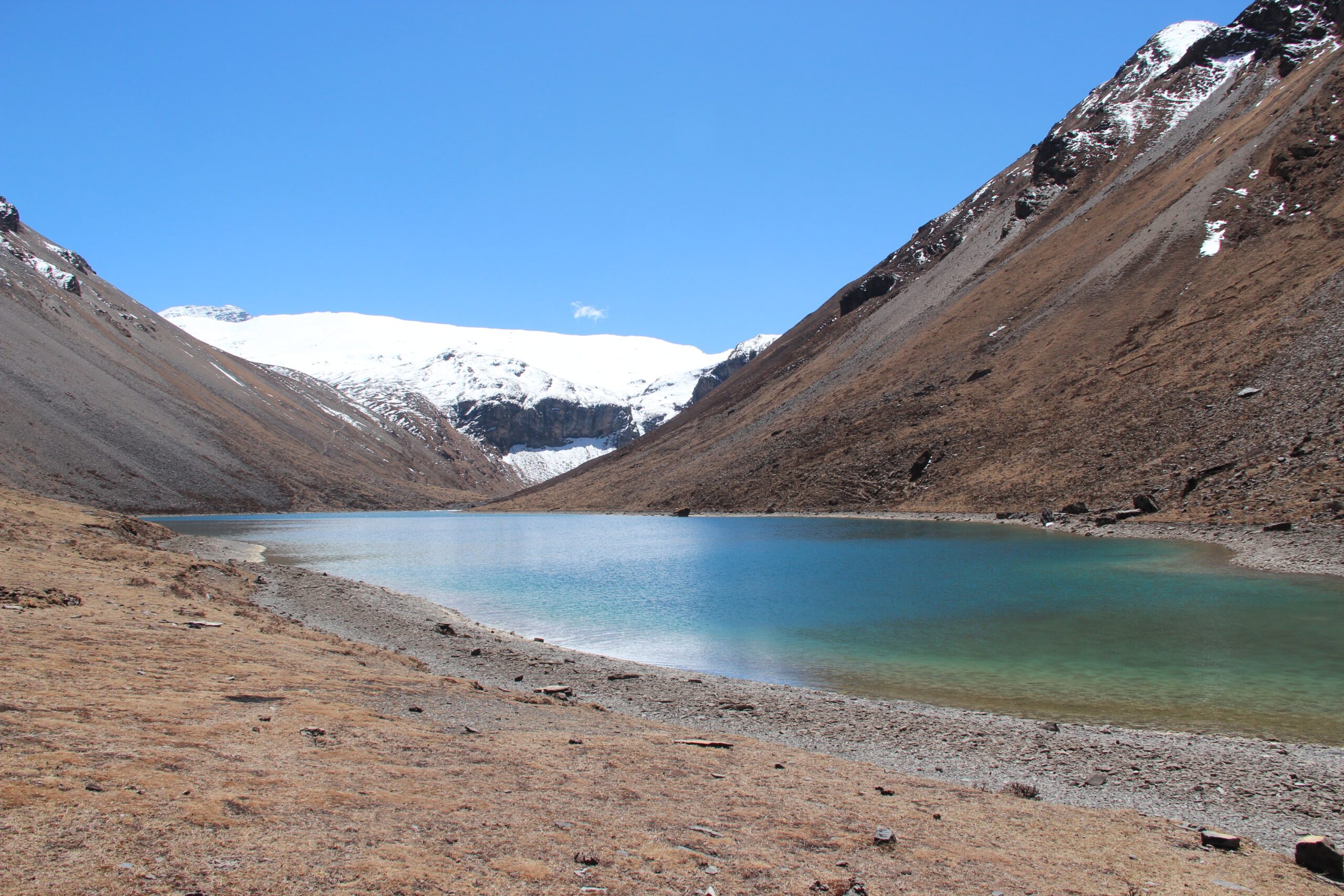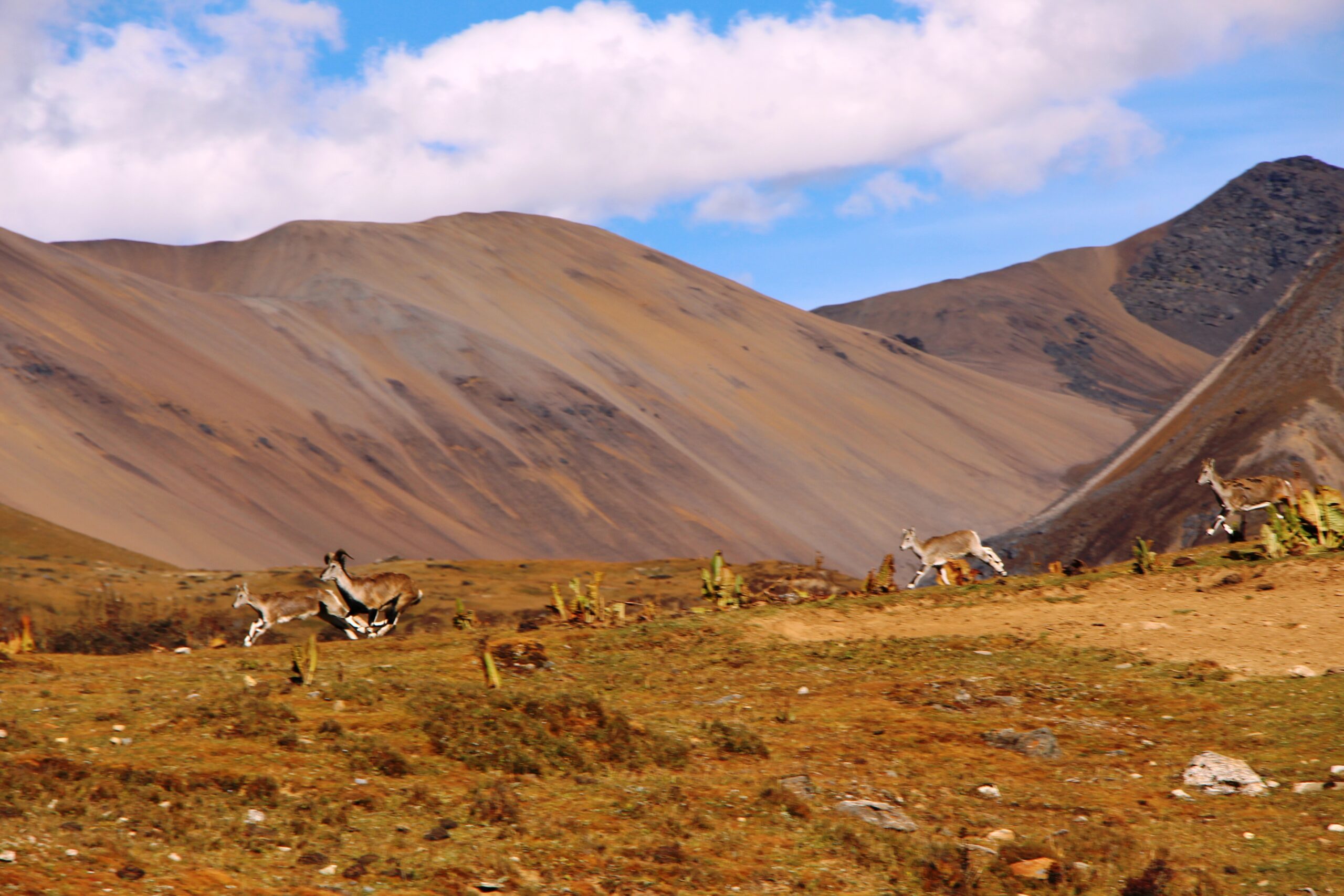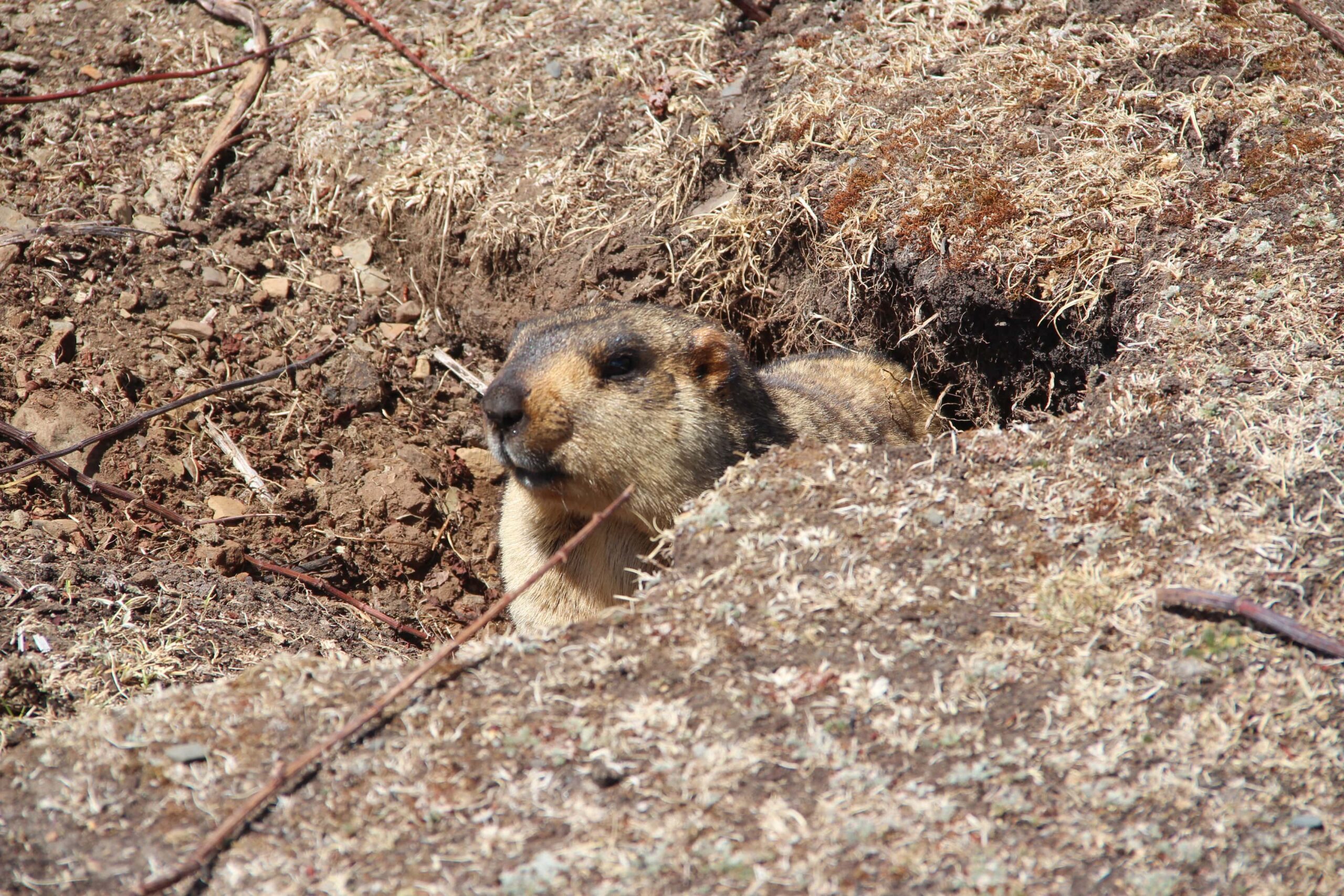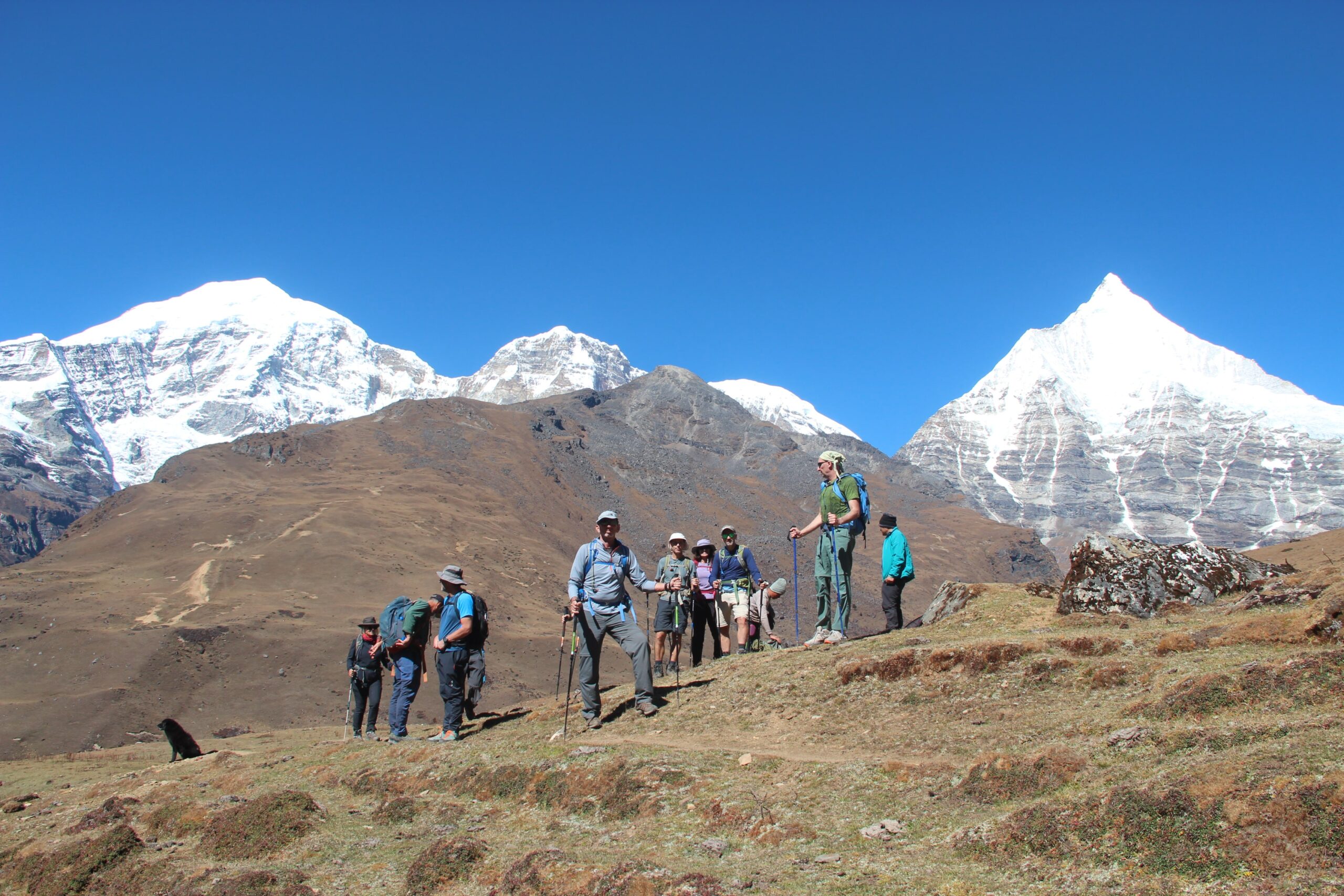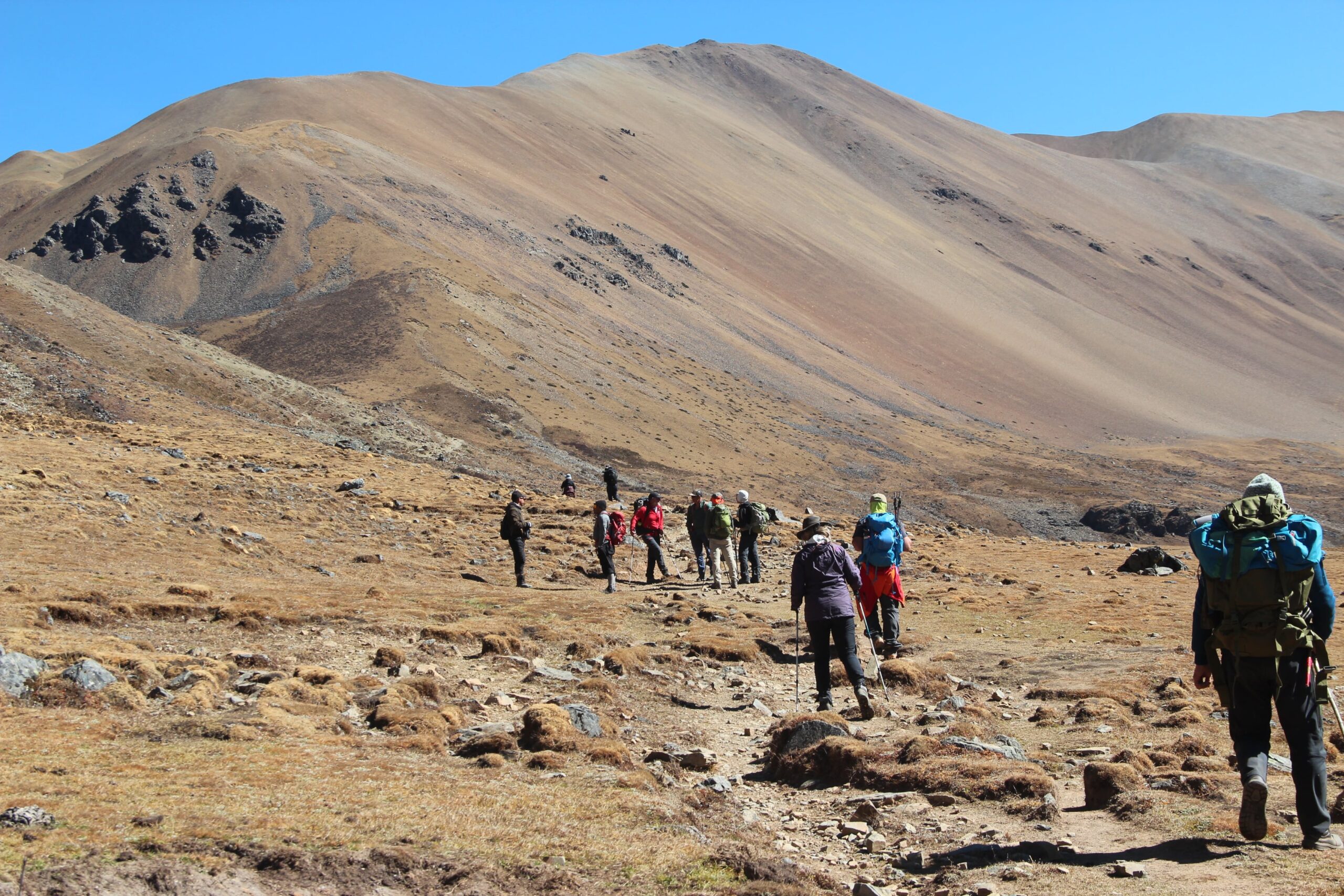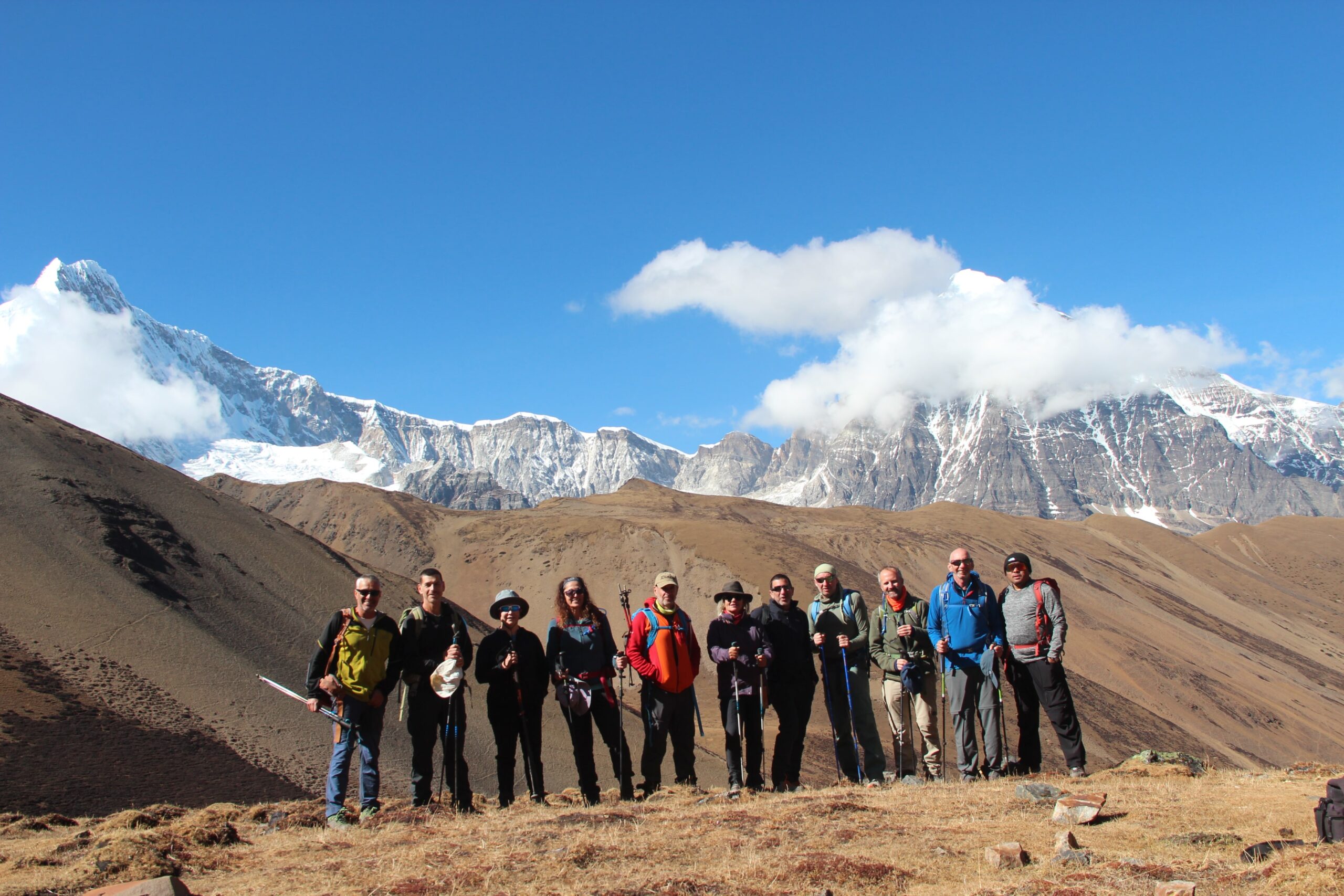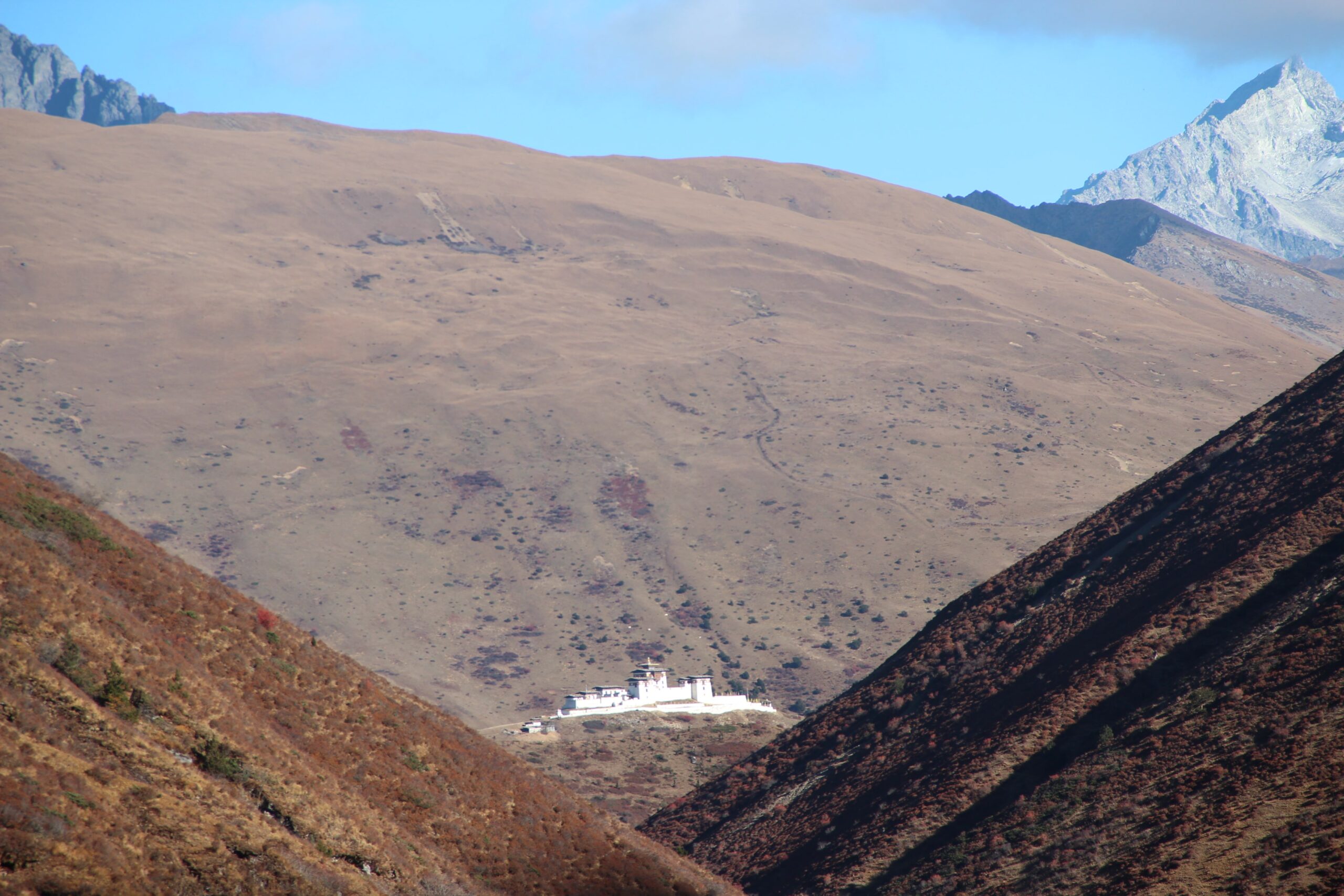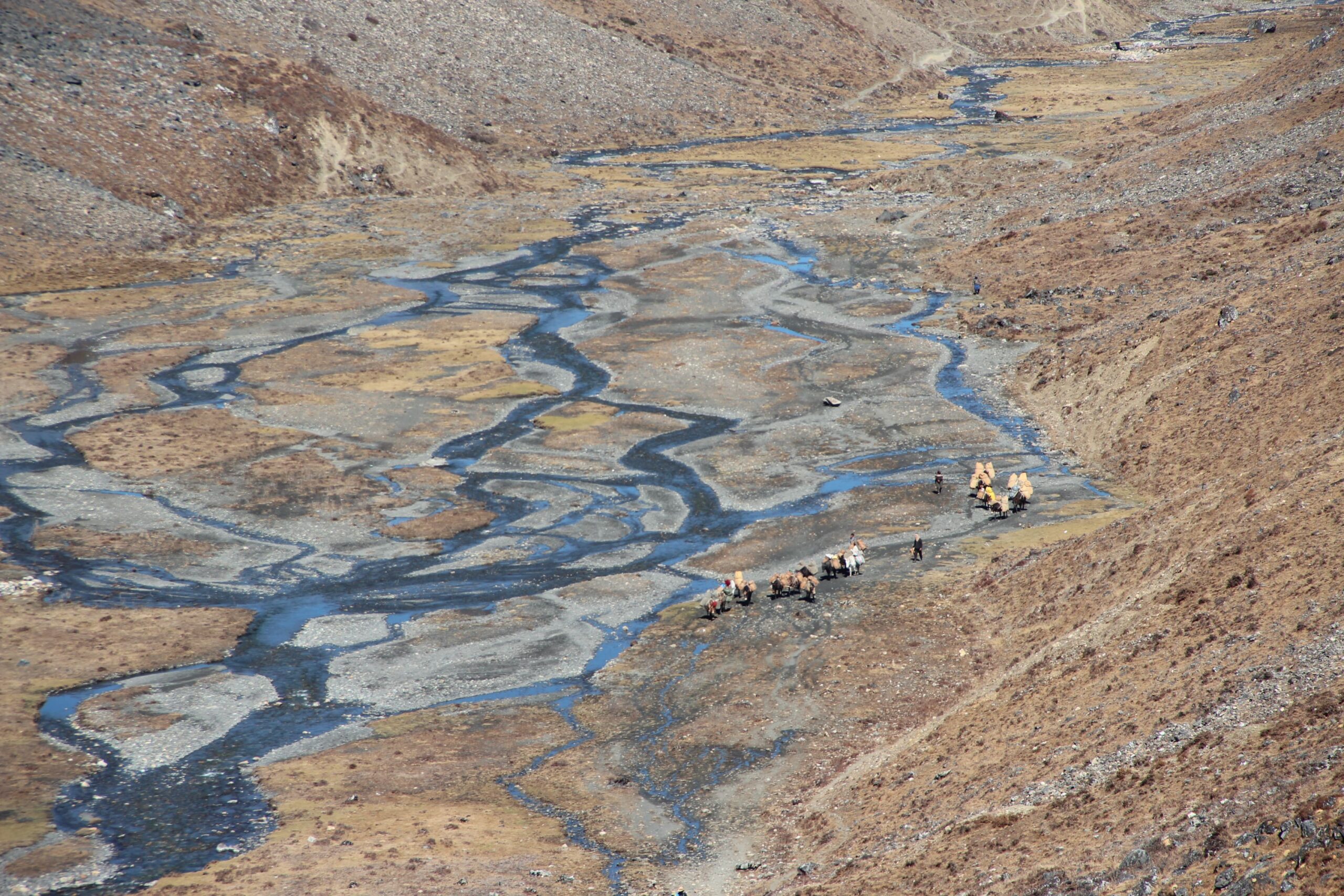This Jumolhari Trek is the best and most beautiful high-altitude among the Jumolhari Treks in Bhutan. The trek will go over two major Passes (Almost 5000 meters) offering terrific mountain views and alpine scenery. This trek also traverses some semi-nomadic settlements. You could spot many yaks, Blue Sheep, and Marmots along the trails. There are also electricity facilities at most campsites on this trek route. The best time for this trek is in the mid-spring and mid-autumn months. So, this is the right trek if you are looking for an alpine/high-elevation trek that is not too long, or too short in the Himalayas.
Trip Map
Day 01: Arrive at Paro
The flight into Paro is a befitting introduction to the spectacular beauty of our country. In clear weather, magnificent views of the world’s highest peaks, give way to the lush green Paro valley as you land. On arrival at Paro International Airport, you will be received by our representative who will escort you to the hotel. In the afternoon visit the Paro Rimpung Dzong, the center of civil and religious authority in this valley. A short walk takes you to the base of the dzong and across a traditional cantilevered, covered bridge. And then have a free stroll in Paro town. And then get back to your hotel and sort out the luggage for your trek. Overnight halt stays at the hotel in Paro.
Day 02: Paro – Tiger’s Nest hike – Shana (Trek begins)
Altitude: 2800m, Duration 5 hours, Distance 15 Km.
Right after your early breakfast drive towards the road point to Taktshang. Taktshang Monastery is the most famous of Bhutan’s monasteries. Taktshang means “Tiger’s Nest,” so named because Guru Rimpoche reportedly flew to the site of the monastery on the back of a flying tiger in the late centuries of the first millennium. The monastery is perched on a cliff nearly 3,000 ft above the Paro valley floor. This day hike is historically and culturally interesting, but also incredibly scenic! It takes about two hours to reach the cafeteria, which gives a breathtaking view of the Tiger’s Nest. If you still feel like hiking then you can take another hour to reach the temple. Have lunch at the café and hike back downhill. Or you can get back to town for lunch.
And then drive towards Drugyel Dzong. Starting from Drukgyel Dzong, the fortress that once guarded Paro Valley against Tibetan invaders, the first day is a pleasant drive through the farm road following the left side of the Pachu River. The farm road serves as the trek route and passes through several tiny villages with traditional houses, rice, and vegetable fields to the left and right of the trail.
After a 20-minute drive from Drukgyel Dzong, you will arrive at Mitsizamp. Crossing a bridge to the right side of the river, the road climbs very gradually for another 30 minutes through the trees to Zakhapang (2,600m). The drive continues through blue pine forests, following the river closely. Gunyitsawa Army outpost appears not long before the end of the first day’s trek. The campsite at Shana, just beyond, is situated at an altitude of 2,820m in a beautiful open space surrounded by blue pine forest. Two traditional houses on the other side of the wide, fast-flowing river make up Shana village. Overnight halt at the camp.
Day 03: Shana -Thangthangka
Altitude 3,750m, Duration 8 hours, Distance 19 Km. Difficulty Level: Long and could be muddy and bumpy paths sometimes.
This is the longest trekking day, taking eight hours to reach the campsite. The trail continues to follow the river gradually ascending through a mixed forest of blue pine and oak and, later in the afternoon, tall rhododendron trees, birch, fir, and maple. Though the trail is a rocky and bumpy path, it is not strenuous but in rainy conditions, it can be quite muddy. There are several simple wooden bridges to cross and sometimes the river reaches right up to the trail. The lunch break comes after about 4 hours of walking through an ever-narrowing valley: Shing Karap or Thombuzam are popular stopping places at around 3,305m. Several trails lead in other directions, such as the trail to Tremo la, which was the old salt-trading route to Tibet. Not long before reaching the campsite the trail leads you up a ridge with a chorten. Beyond, in the distance, at the end of the valley the Jumolhari Mountain comes into view. Finally, after an 8-hour walk, you reach the campsite. The campsite is located in a spacious clearing and directly faces Mount Jumolhari. The view of the early morning sun striking the tip of Jumolhari is breathtaking. Mount Jumolhari, at 7326, is among the world’s highest mountains.
Day 04: Thangthangka – Jangothang
Altitude: 3610m/4050m (Total Altitude Gain: 440m) Duration 5 hours, Distance 16 Km, Difficulty Level: Short and easy.
The third day’s trek is a short one so, it is possible to set off a little later and progress at a leisurely pace. When you reach the army outpost, you are required to stop and register your entry permits issued by the army headquarters in Thimphu. This matter will be taken care of by your guide. The Pachu River is again to the right and the trail passes through some tiny villages. It will take a maximum of 5 hours to reach Jangothang, Base Camp. The base camp is at 4,050m and is a beautiful place to spend the night. The imposing, rounded bulk of the Jumolhari Mountain fills the view to the Northeast, and in the evening the profile of the ruined Jangothang Dzong, populated by huge ravens creates a mystical atmosphere. The area is rich in bird life. Birds sighted en route include the Fire-tailed Sunbird, Ibisbill, White throated Dipper, Yellow-billed Chough, Rosy Pipit, Snow Pigeon, Blue-fronted Redstart, Plumbeous Water Redstart, Blood Pheasant, Snow Partridge and many more.
Day 05: Acclimatization/Exploration Day
Today is a rest and acclimatization for the next day’s highest climb on this trek. You will hike to explore nearby mountains and lakes like Tshophu, Jomolhari Base, or Jitchu Drake Base which will take around 3-4 hours to and fro. And then return to the camp for lunch and take a rest in the afternoon.
Day 06: Jangothang – Lingshi
Altitude: 4050m/4000m (Total Altitude loss: 50) Duration 6 hours, Distance 15 Km, Difficulty Level: Strenuous.
As you climb steeply above the base camp and into an area of glacial moraine, the views of Jichu Drakey and Jomolhari change along with your perspective. A steep and steady climb, sometimes through snow, brings you to the Nylie-La pass at 4,890 meters.
From the top of the windy pass enjoy the 380-degree view. Tshering Gang (6,789) also comes into full view. A fairly tough trek over the pass leads down to the valley and then follows the side of a ridge towards the impressively situated Lingshi Dzong (4,370m). The camp site is some distance below the Dzong on a flat area near by a glacier river, at an altitude of 4000m.
Day 07: Lingshi – Shodu
Altitude: 4000m/3,815m (Total Altitude loss: 185m), Duration 7-8 hours, Distance 19 Km. Difficulty Level: Long and difficult
The trail to Shodu starts with a climb towards a chorten on a ridge opposite the camp and into the Mo-chu valley. After crossing the river, the ascent towards the Yele-La (4,950m) begins. It takes 2 to 3 hours to reach the pass from where there are views of the snowy peaks of Jumolhari, Gang-Chenta, Tshering-Gang, and Masang-Gang. In places, the paths are sometimes quite narrow and cut into the rock face. At Jimenameshing there are many large boulders and switchbacks. Many find this route quite difficult because of the rocks, boulders, and pebbles. After a tiring day’s ascent, the descent to the campsite in a meadow at Shodu (3,815m) is quite short. Since this is the main trail to Thimphu, you may meet other Bhutanese travelers En route or at the camp.
Day 08: Shodu – Barshong – Thimphu (Drive)
Altitude: 3,815m/3,685m (Total Altitude loss: 130m), Duration 4-5 hours, Distance 16 Km. Level of Difficulty: Moderate and pleasant.
The river that you are now following is the Thimphu Chu and you will stick closely to the river all day, crisscrossing back and forth over log bridges and passing through an area with steep rock faces and beautiful waterfalls. After crossing to the left bank, the trail then ascends towards the ruins of Barshong Dzong (3720). The Barshong campsite is here but, your car and driver will be waiting for you to drive to Thimphu since the unpaved motor roads arrived here a few years ago. The drive on this unpaved road will take nearly 2 hours until you connect to a proper paved road at Dodena. From Dodena it’s just a 30 minutes’ drive to your hotel in Thimphu for a nice shower. And then in the evening stroll around the capital city to see the life of urban Bhutan.
Day 09: Thimphu sightseeing – Paro
After breakfast, drive to Buddha Point to see one of the largest Buddha statues in the world with a panoramic view of the whole Thimphu city. After that, visit the Jungshi Paper factory to see how the Bhutanese hand-made papers are made, they also have a gallery shop where you buy fine finished paper products. Visit the Takin Zoo to see our national animal. Afterward, visit a handicrafts shop/craft bazaar if you like to do some souvenir shopping. After lunch, drive to Paro. Upon arrival in Paro, you can have a complimentary traditional Hot Stone Bath in a farmhouse which will relieve your muscles and leg pains after your week’s trek. You can also taste Butter tea, local roasted rice/typical snacks, and Ara (Distilled local wine) while you are at the farmhouse. Today, if you like, you can eat a typical Bhutanese meal at the farmhouse. Overnight halt stays at the hotel in Paro.
Day 10: Paro–Flight Depart
After breakfast, our guide and driver will drop you off at the airport and bid you goodbye for your international flight departure for your onward flight back home.
Have a pleasant flight back home!
The minimum daily package covers the following services:
- Peak Season Cost: March, April, May, September, October & November
Staring Cost: USD 2,470 per person.,
Note: Single Room Supplement Cost is, USD 35 per night for 3 Star hotels, USD 65 per night for 4 Star Hotels and around USD 300 for 5 Star Hotels.
These rates are applicable per tourist per night halt in Bhutan.
1. What sort of past acclimatization/elevation and exercises do you need for this trek?
Ans – One must have done minimum 5-Day trek with at least 3300 meters and above quite recently and must be healthy and fit.
2. What is the minimum number of people required for the trek, and when is the best time or season?
Ans – We normally require minimum 2 people for the trek. yet, we can also conduct the trek for one person also. However, you will have to bear little additional cost. The best time for the trek is in the late spring or end of May, and then in the fall toward the end September.
3. What is the procedure for this trek booking?
Ans – You will have book this trek at least two months ahead with your confirmed flight booking. And then must deposit US $850 each/30% as an Advance Payment with full airfare only for your flight to/from Paro, Bhutan.
4. Why shall we book this adventure trek with your company?
Ans – We are one of the most local adventures travel company who can render personalized services, with value for money. We make sure to provide very good weather proof trekking equipment, skilled guide/tour leader, good cook and helpers, transports, etc, etc. And we arrange the trek on right time/season, so that it’s mostly a successful trek.
5. Do you apply our Bhutan Visa and what are the documents required for the Visa?
Ans – Yes, we will issue your Bhutan Visa upon receiving the full payment from you. And we only need your clear passport copy for applying the Visa.
6. Do we need to bring our sleeping bag, if so what type or how warm it must be?
Ans – Yes, you will have to bring your own sleeping bag. And it must be minimum minus 20 Degree Celsius dawn feather sleeping bag.
7. What are available flights connecting Bhutan with other cities, and what is the most convenient flight to/from Bhutan. And do you book the flights too?
Ans – We have flights to and from Bangkok, Kathmandu, Delhi, Kolkata, Dhaka, Singapore, Bagdogra and Guwahati. Yet, the most convenient flights to/fro Paro, Bhutan is via Bangkok as we have several flights in a day. Yes, we will book your flight as well, unless you want to do it at your end.


